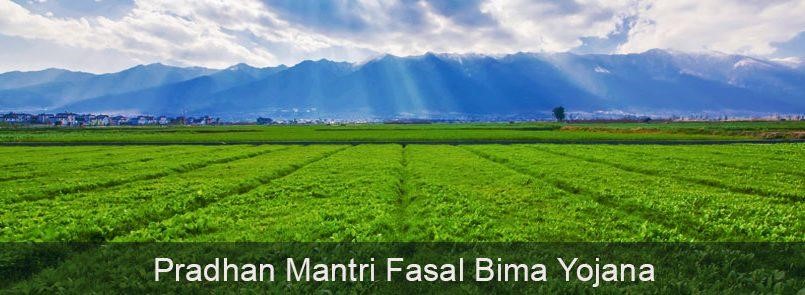Agriculture plays an extremely important role in the Indian economy. Our country is also known as the land of farmers. Our farmers indeed are the backbone of the economy and our agriculture significantly contributes to the Gross Domestic Product (GDP).
It becomes important that any risks or perils within this sector and our farmers need to be taken proper care of always. The
Pradhan Mantri Fasal Bima Yojana aims at supporting sustainable production in the agriculture sector.
In this article, let us know more about the PMFBY scheme.
What is PMFBY?
In simple words, the PMFBY is a crop insurance scheme initiated by the Ministry of Agriculture and Farmers’ Welfare and was launched on February 18, 2016.
It is a crop insurance scheme that aims at providing financial aid to the farmers in times of loss/damage to crops under the unforeseen circumstance. The PMFBY scheme can be taken from selective insurance companies in India, some financial institutions like co-operative or commercial banks, panchayat raj, the government department of agriculture, etc.
Objective of PMFBY
Let us take a glance at the key objectives of PMFBY crop insurance in India:
- To provide the Indian farmers with optimum insurance coverage and financial support in case any loss or damage is incurred to the crop. This could be due to various factors such as crop diseases, natural calamities, and pests.
- Stabilizing farmer's income and making it certain that they continue farming
- Encouraging the Indian farmers to adopt both innovative and modern practices of agriculture.
- Ensuring credit flow to the Indian agriculture sector. It will contribute to crop diversification and food security, and enhance the growth and competitiveness in the sector. Moreover, it also secures farmers from the production perils/risks.
Coverage Offered Under PMFBY
The following risks leading to crop loss are covered under the Pradhan Mantri Fasal Bima Yojana scheme:
- Yield Losses (Standing Crops, on a Notified Area Basis): A comprehensive risk insurance is offered to cover the yield losses because of non-preventable risks listed below:
- Cyclone, hailstorm, hurricane, storm, tempest, tornado, typhoon, etc.
- Natural fire and lightning
- Pests or diseases
- Drought, dry spells
- Flood, inundation, and landslide
- Post Harvest Losses (Individual Farm Basis): A coverage is accessible for a maximum of 14 days from harvesting of those crops that are kept in ‘cut and spread condition. It is done to dry in the field after harvesting, against certain risks of unseasonal/cyclonic rains or cyclones throughout the nation.
- Prevented Sowing (Notified Area Basis): If the majority of the insured farmers are prevented from planting or sowing the insured crop due to adverse weather conditions are entitled to indemnity claims. These indemnity claims can go up to 25% of the maximum sum insured.
- Localized Calamities (Individual Farm Basis): Any loss or damage incurred due to identified localized risks such as the hailstorm, inundation, and landslide that affect the isolated farms in the area notified.
Exclusions of PMFBY Scheme
Now, you know what remains covered under the Pradhan Mantri Fasal Bima Yojana. Moving ahead let us touch down on the exclusions of the PMFBY scheme in India.
Any risks or losses arising out of the below-mentioned risks remain uncovered under PMFBY:
- War and related perils
- Nuclear risks, riots
- Theft
- Malicious damage
- Act of enmity/hatred
- Destroyed or grazed by domestic/wild animals
- In the case of post-harvest losses wherein the harvested crop was kept at an unsafe place leading to preventable damage
Things to Know About PMFBY
Certain aspects need to be kept in mind when it comes to PM Fasal Bima Yojana. Keeping a note of these will help to reap the maximum
PMFBY benefits:
- To apply for the PMFBY scheme, click on the link: https://pmfby.gov.in
- The key objective of the scheme is to assist the farmers in getting out of financial distress. The crop insurance premium rates are fixed; however, cost-effective
- The table below shows the insurance charge rate payable by the farmer:
| Season |
Crops |
Maximum Insurance Charge Payable by the Farmer (% of SI) |
| Rabi |
Pulses, cereals, millets, and oilseeds crops |
1.5% of the sum insured or actuarial rate whichever is less |
| Kharif |
Pulses, cereals, millets, and oilseeds crops |
2% of the sum insured or actuarial rate whichever is less |
| Kharif and Rabi |
Annual Horticultural/Commercial crops |
5% of the sum insured or actuarial rate whichever is less |
- Under adverse environmental conditions like scarcity of rain, etc. the farmers must avoid planting, sowing, or germination activities on the land notified
- To obtain compensation for the localized losses the farmer or the agency should inform the respective officials about the incurred loss on their own
Wrapping it Up
The
Pradhan Mantri Fasal Bima Yojana is a great initiative to help Indian farmers in the best possible way. The crop insurance policy is also encouraging farmers to remain competitive and also improve quality of the crop production.
Remember, farmers are the heart of India and crops are their main source of income.
One Nation, One Crop, One Premium
*Standard T&C apply
Insurance is the subject matter of solicitation. For more details on benefits, exclusions, limitations, terms, and conditions, please read the sales brochure/policy wording carefully before concluding a sale.
 Service Chat:
Service Chat: 

